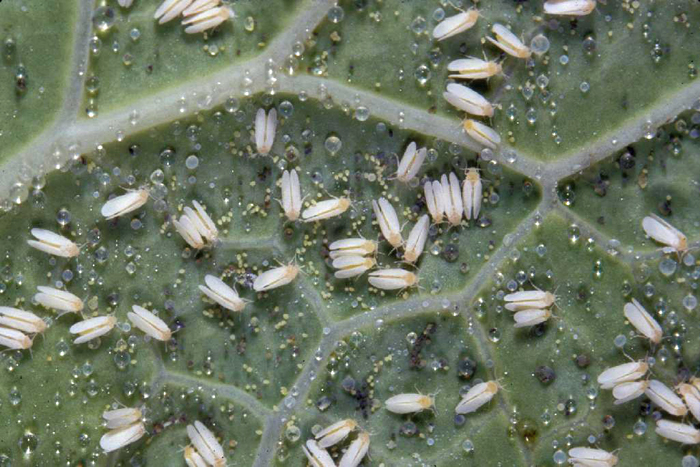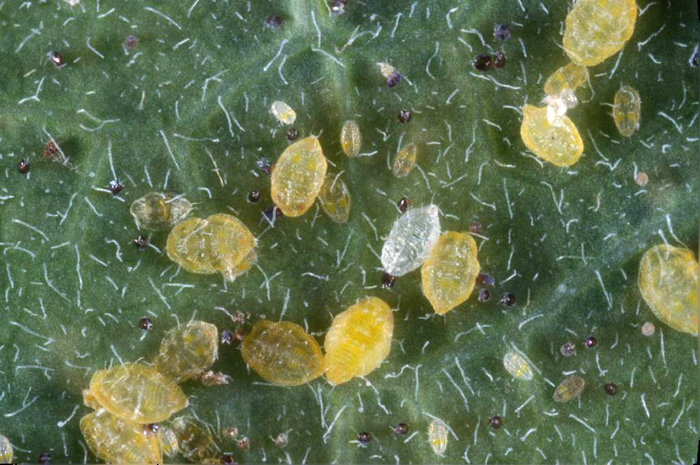Sliverleaf whiteflies (SLWF), also known as sweet potato whiteflies, are a major pest in many cropping systems. The SLWF has a broad feeding range of over 600 host plants, which includes ornamental, vegetable, and field crops. This season, large populations of silverleaf whiteflies have been reported in in cotton in Georgia, Alabama, and now Florida’s Panhandle.
Females deposit eggs on the underside of leaves. Once an egg hatches, the first instar in the SLWF life cycle is referred to as a “crawler.” As the name implies, during this stage the immature instar will crawl on the leaf underside until selecting a location to feed. Once settled, the remaining stages of its life cycle are immobile until it reaches adulthood. Both the adult and immature SLWF have sucking mouthparts, which they use to feed on plant juices. SLWF excrete honeydew, a waste composed largely of sugars. This honeydew provides a perfect enviroment for sooty mold development on the leaf tissue, which can impact photosynthesis, as well as cause the cotton lint to stick together making it difficult to gin. Feeding damage from SLWF can also result in premature defoliation. SLWF populations will increase and pose a threat to cotton until it is defoliated or the leaves drop from feeding injury.
University of Georgia Extension Entomologist, Dr. Phillip Roberts published the article Georgia Cotton: Whitefly Infestations Across the State – What Can You Do? a few weeks ago. The article discusses thresholds and other key management factors. A summary for most of his article can be found below. Dr. Ron Smith of Auburn University also published the article Silverleaf Whitefly Control in Cotton that also discusses SLWF management.
Scouting Summary:
When scouting cotton for SLWF, select the fifth mainstem leaf below the terminal to check for infestations. Sample at least 30 random plants in the field, avoid edges by moving at least 25 paces into the field and then keep selected plants about 10 paces apart. Treatment is recommended when 50 percent of sampled leaves have 5 or more immature crawlers. Keep in mind that late planted cotton has a higher risk for SLWF infestations, as well as hairy leaf varieties in comparison to those with a smooth leaf.
Treatment Summary:
Insect Growth Regulators (IGRs) such as Knack and Courier are the main component of SLWF management programs in cotton. Their effects on SLWF populations are generally slow due to the stages they target in the insect life cycle, but these types of products have long residual activity. With large infested areas across the southeast, certain products are becoming harder to obtain due to treatment demand. Other products with whitefly activity include Assail, Sivanto, and Venom which target all stages of the insect’s life cycle. Oberon is another product used, which treats primarily nymphs.
It is important to note the role beneficial insects play in the field. Natural enemies of the SLWF include lacewings, minute pirate bug, and some species of ladybug. These types of insects can be conserved by avoiding use of broad spectrum insecticides such as pyrethroids, unless other pest thresholds are reached. Pyrethroids can be identified by looking at the active ingredient listed on a product label, their common name will end in -thrin or –ate. Examples of these types of products include Bifenthrin, Karate, and Orthene.
For more information consult the following articles, or contact your local Extension Agent.
Georgia Cotton: Whitefly Infestations Across the State – What Can You Do?
Silverleaf Whitefly Control in Cotton
- 2025 Peanut Field Day Recap & Speaker Handouts - August 29, 2025
- Peanut Foliar Diseases Exploding Across Florida - August 22, 2025
- Provisional Nitrogen Fertilization Recommendation for Florida Cotton for the 2025 Season - June 20, 2025


